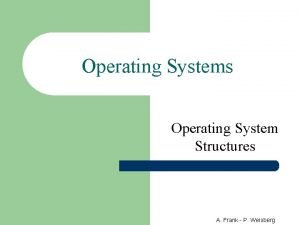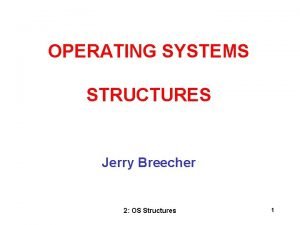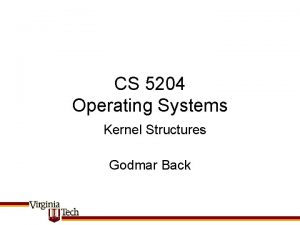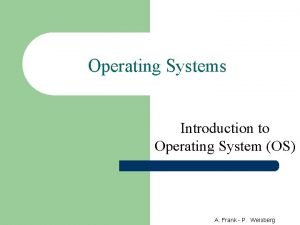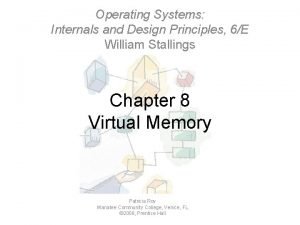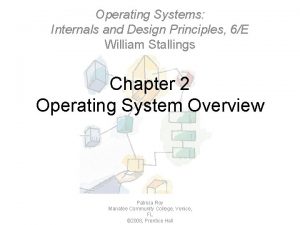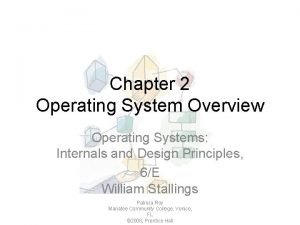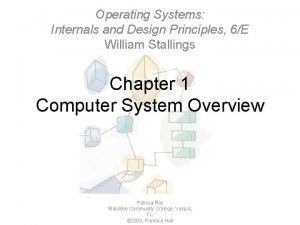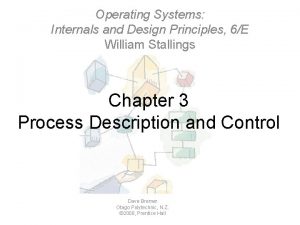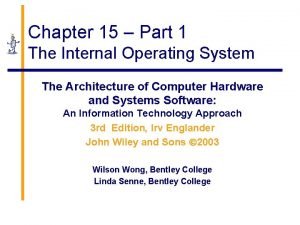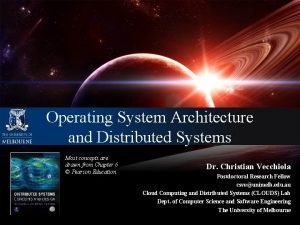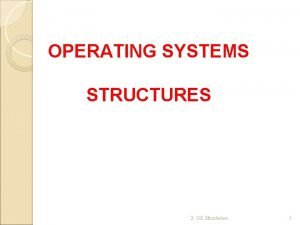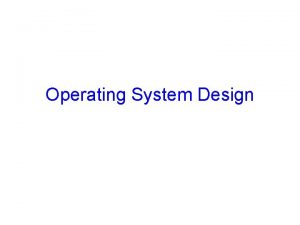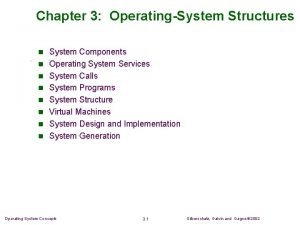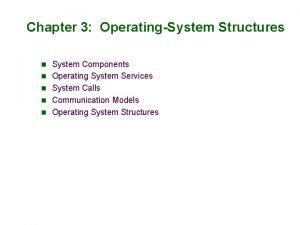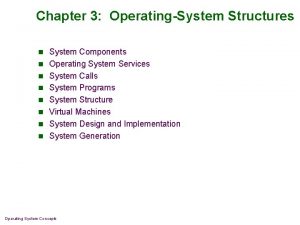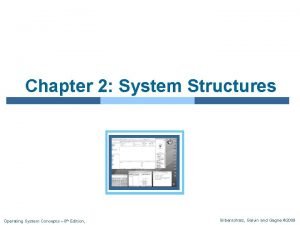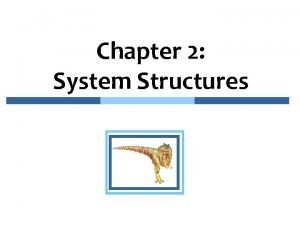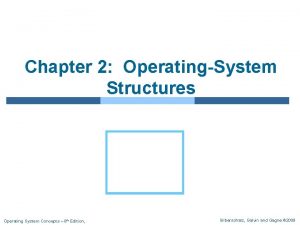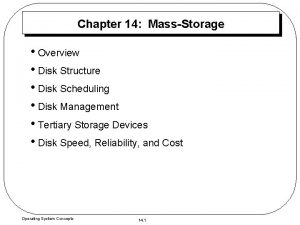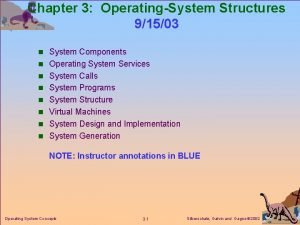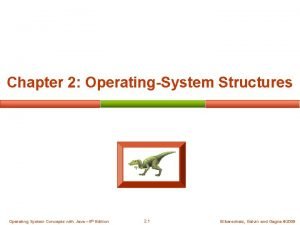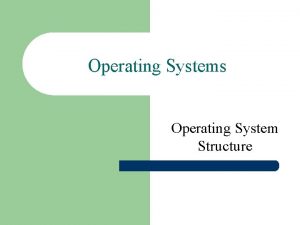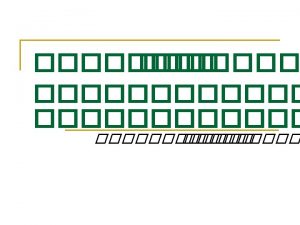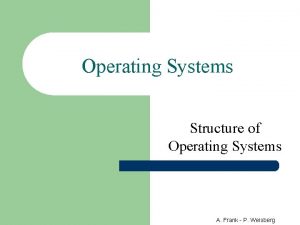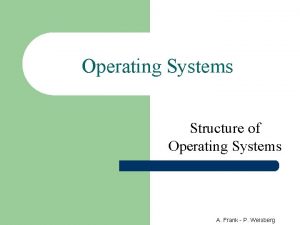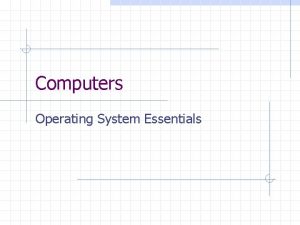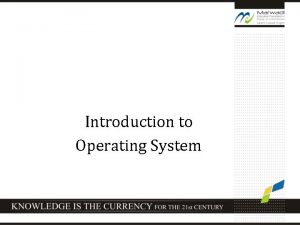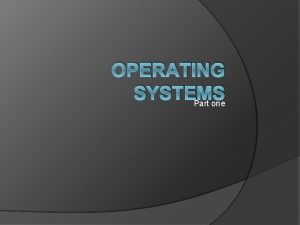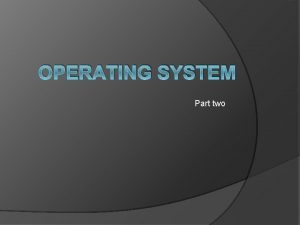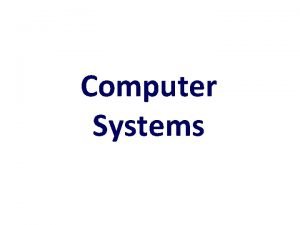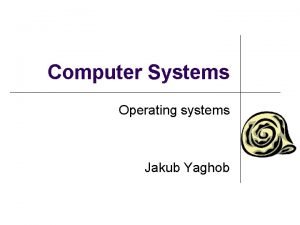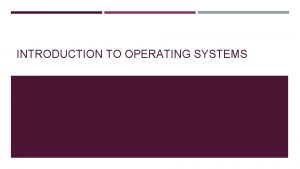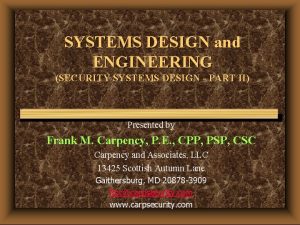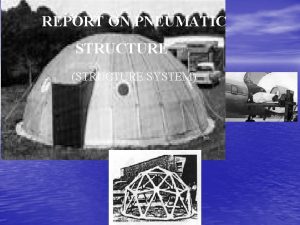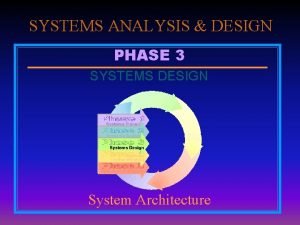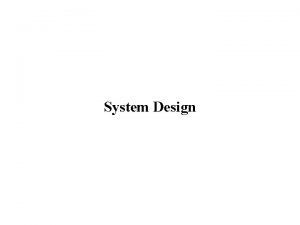Operating Systems Structure Part 2 Operating System Design
























- Slides: 24

Operating Systems Structure Part 2

Operating System Design and Implementation (Cont. ) � Important principle to separate Policy: What will be done? Mechanism: How to do it? � Mechanisms determine how to do something, policies decide what will be done � The separation of policy from mechanism is a very important principle, it allows maximum flexibility if policy decisions are to be changed later (example – timer) � Specifying and designing an OS is highly creative task of software engineering

Implementation � Much variation ◦ Early OSs were designed in assembly language (low level symbolic language converted by an assembler) ◦ Then system programming languages like Algol, PL/1 ◦ Now C, C++ � Actually usually a mix of languages ◦ Lowest levels in assembly ◦ Main body in C ◦ Systems programs in C, C++, scripting languages like PERL, Python, shell scripts � More high-level language easier to port to other hardware ◦ But slower � Emulation can allow an OS to run on non-native hardware

Operating System Structure ◦ Simple structure – MS-DOS ◦ More complex -- UNIX ◦ Layered – an abstraction ◦ Microkernel -Mach

Simple Structure -- MS-DOS � MS-DOS – written to provide the most functionality in the least space ◦ Not divided into modules ◦ Although MS-DOS has some structure, its interfaces and levels of functionality are not well separated

Non Simple Structure -- UNIX – limited by hardware functionality, the original UNIX operating system had limited structuring. The UNIX OS consists of two separable parts ◦ Systems programs ◦ The kernel �Consists of everything below the system-call interface and above the physical hardware �Provides the file system, CPU scheduling, memory management, and other operating-system functions; a large number of functions for one level

Traditional UNIX System Structure Beyond simple but not fully layered

Layered Approach � The operating system is divided into a number of layers (levels), each built on top of lower layers. � The bottom layer (layer 0), is the hardware; the highest (layer N) is the user interface. � With modularity, layers are selected such that each uses functions (operations) and services of only lowerlevel layers

Microkernel System Structure � Moves as much from the kernel into user space � Mach example of microkernel ◦ Mac OS X kernel (Darwin) partly based on Mach � Communication takes place between user modules using message passing � Benefits: ◦ ◦ Easier to extend a microkernel Easier to port the operating system to new architectures More reliable (less code is running in kernel mode) More secure � Detriments: ◦ Performance overhead of user space to kernel space communication

Microkernel System Structure

Modules � Many modern operating systems implement loadable kernel modules ◦ ◦ Uses object-oriented approach Each core component is separate Each talks to the others over known interfaces Each is loadable as needed within the kernel � Overall, similar to layers but with more flexible ◦ Linux, Solaris, etc

Solaris Modular Approach

Hybrid Systems � Most modern operating systems are actually not one pure model ◦ Hybrid combines multiple approaches to address performance, security, usability needs ◦ Linux and Solaris kernels in kernel address space, so monolithic, plus modular for dynamic loading of functionality ◦ Windows mostly monolithic, plus microkernel for different subsystem personalities � Apple Mac OS X hybrid, layered, Aqua UI plus Cocoa programming environment ◦ Below is kernel consisting of Mach microkernel and BSD Unix parts, plus I/O kit and dynamically loadable modules (called kernel extensions)

Mac OS X Structure

i. OS � Apple mobile OS for i. Phone, i. Pad ◦ Structured on Mac OS X, added functionality ◦ Does not run OS X applications natively �Also runs on different CPU architecture (ARM vs. Intel) ◦ Cocoa Touch Objective-C API for developing apps ◦ Media services layer for graphics, audio, video ◦ Core services provides cloud computing, databases ◦ Core operating system, based on Mac OS X kernel

Android � Developed by Open Handset Alliance (mostly Google) ◦ Open Source � Similar stack to IOS � Based on Linux kernel but modified ◦ Provides process, memory, device-driver management ◦ Adds power management � Runtime environment includes core set of libraries and Dalvik virtual machine ◦ Apps developed in Java plus Android API �Java class files compiled to Java bytecode then translated to executable than runs in Dalvik VM � Libraries include frameworks for web browser (webkit), database (SQLite), multimedia, smaller libc

Android Architecture

Operating-System Debugging � Debugging is finding and fixing errors, or bugs � OS generate log files containing error information � Failure of an application can generate core dump file capturing memory of the process � Operating system failure can generate crash dump file containing kernel memory � Beyond crashes, performance tuning can optimize system performance ◦ Sometimes using trace listings of activities, recorded for analysis ◦ Profiling is periodic sampling of instruction pointer to look for statistical trends Kernighan’s Law: “Debugging is twice as hard as writing the code in the first place. Therefore, if you write the code as cleverly as possible, you are, by definition, not smart enough to debug it. ”

Performance Tuning � Improve performance by removing bottlenecks � OS must provide means of computing and displaying measures of system behavior � For example, “top” program or Windows Task Manager

Operating System Generation Operating systems are designed to run on any of a class of machines; the system must be configured for each specific computer site � SYSGEN the process of configuring or generating an instance of an operating system for each individual computer site/architecture.

System Boot � When power initialized on system, execution starts at a fixed memory location ◦ Firmware ROM used to hold initial boot code � Operating system must be made available to hardware so hardware can start it ◦ Small piece of code – bootstrap loader, stored in ROM or EEPROM locates the kernel, loads it into memory, and starts it ◦ Sometimes two-step process where boot block at fixed location loaded by ROM code, which loads bootstrap loader from disk � Common bootstrap loader, GRUB, allows selection of kernel from multiple disks, versions, kernel options � Kernel loads and system is then running

Revision questions � List at least three operating system services that are useful to users. � List at least three operating system functions that maintain efficient operation of the system. � What are the two different approaches for providing a user interface? � What is a system call? � What kernel data structure can be used for one technique of passing parameters to system calls? � List at least three of the major categories of system calls. � A program that has been loaded and executing is called a _____.

Revision questions cont; � � � � What part of the operating system makes the decision with regards to which job will run? List at least three of the categories of system programs. True or False? The view most users see of the operating system is defined by application and system programs rather than system calls. What are the two basic goal groups that must be considered when designing an operating system? What is the difference between policy and mechanism? List at least three different ways for structuring an operating system. List at least two different hybrid operating systems. What are the two devices that run the i. OS operating system?

Revision questions cont; � � � � What technique do microkernels use to communicate between services? Provide an example of an operating system that uses the simple structure. True or False? Performance tuning is a type of debugging. Name two activities the operating system is responsible for in connection with disk management. Of the following 5 forms of storage, rank them from fastest to slowest in terms of access time: What does the term SYSGEN refer to? What is the name of the small piece of code that locates the kernel and loads it into main memory?
 Structure of an operating system
Structure of an operating system Operating system
Operating system Operating systems structure
Operating systems structure Operating systems
Operating systems Design issues of distributed system
Design issues of distributed system Operating systems: internals and design principles
Operating systems: internals and design principles Slidetodoc.com
Slidetodoc.com Operating systems: internals and design principles
Operating systems: internals and design principles Operating systems: internals and design principles
Operating systems: internals and design principles Operating systems: internals and design principles
Operating systems: internals and design principles Operating systems internals and design principles
Operating systems internals and design principles Operating systems internals and design principles
Operating systems internals and design principles Internal operating system
Internal operating system Architecture of operating system
Architecture of operating system Simple structure in os
Simple structure in os Layered structure in os
Layered structure in os Operating system structure
Operating system structure Operating system structure
Operating system structure Structure of operating system
Structure of operating system Operating system structure
Operating system structure Operating system structure
Operating system structure Monolithic structure in os
Monolithic structure in os Moving head disk mechanism
Moving head disk mechanism Structure of operating system
Structure of operating system Structure of operating system
Structure of operating system
